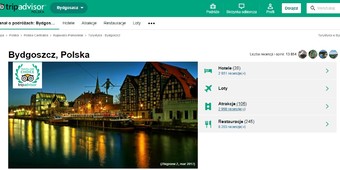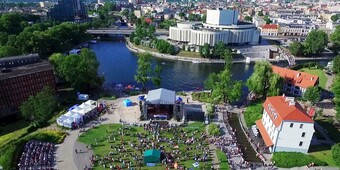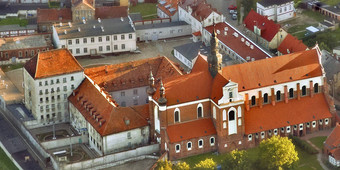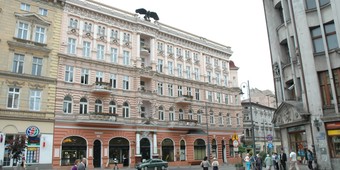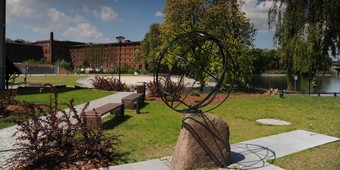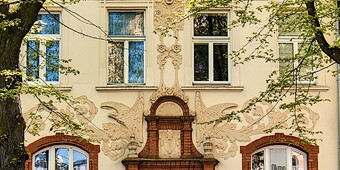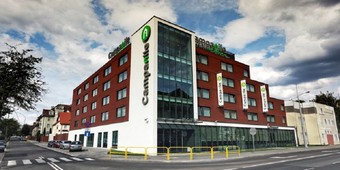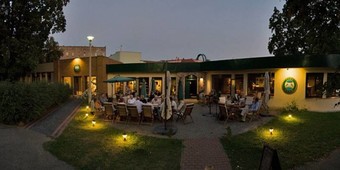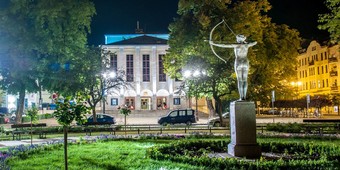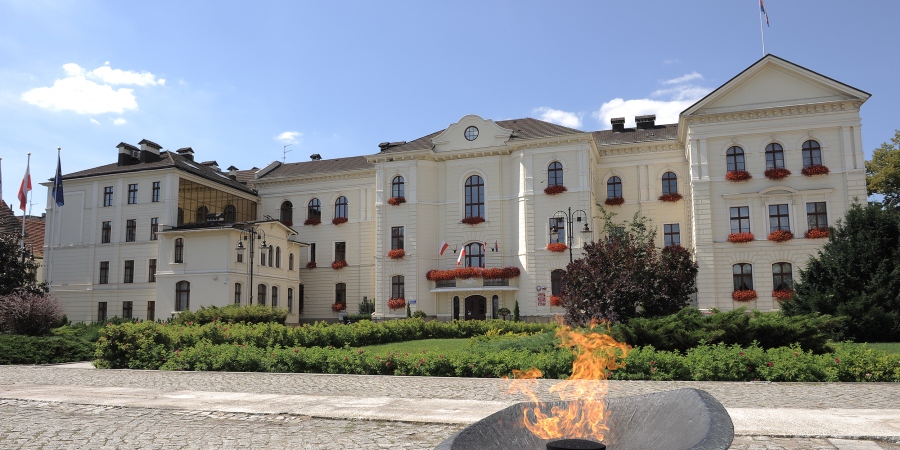
The Bydgoszcz Town Hall, fot. R.Sawicki
The Bydgoszcz Town Hall is the heart of the city. Together with the town church (Fara), its walls and gates have always been one of the foundations of the medieval city. The current City Hall building also has a nearly 400-year-long history.
Initially, it was associated with the Jesuit Order and their college. The first Jesuits arrived in Bydgoszcz as early as 1616.
In 1649, thanks to the economic support of Bishop Kasper Działyński (founder of the famous Calvary in Pakość among others), the Chancellor of the Crown, Jerzy Ossoliński (mayor of Bydgoszcz), and wealthy citizens who had previously acquired property and houses in the western side of the market, the Bydgoszcz Jesuits built a two-towered Baroque church. Earlier, in 1637 the Jesuits had bought a house next door for educational purposes. Initially a small school, it later turned into a so-called "residence", which in 1674 was given the title of College.
The large College building (now the Bydgoszcz City Hall) was built in the years 1644 to 1653. The College was designed primarily for the children of the local gentry and burghers of Bydgoszcz, Gdansk and Braniewo. The new expanded building of the College was completed in 1695. The Jesuit College, which is de facto the first higher institution in Bydgoszcz, was a very important educational and cultural centre for the entire region. In addition to the typical scientific and educational activities, the College was home to recognized music groups and theatrical productions were also performed. From around 1623, a fully professional theatre group was present at the College, for which a special room with a stage was allocated, which could sit about 300 people. The room remained functional until 1822, organizing municipal theatre performances on the former Carmelite monastery premises (in the area of today's Teatralny Square).
An occasion that remained in the memory of the great College was the visit of King Stanisław Leszczyński. On 29 September 1734 in honor of the king, a great feast was held, at which college professors praised the royal guest in verse and prose, the college group held a concert, and a Jesuit march-band was organized. According to modern criteria, such "events" would not qualify as "artistic", but certainly loud and inspiring.
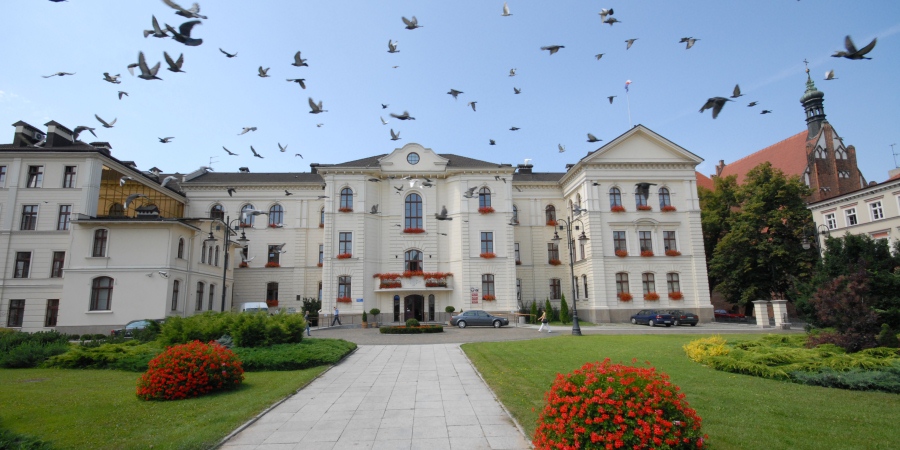
Town Hall in Bydgoszcz, fot. R.Sawicki
The Jesuit College (with its church, convent, boarding school and farm buildings from the beginning of the eighteenth century) was the largest building complex in the city. Visiting Bydgoszcz at the time, Bishop Załęski writes about the complex:
"These buildings, together with the church, form a great square, a true ornament in the market and the city. Despite of this, the Jesuits continue to build more, as until 1760 the College Rector was also praefectus fabricae, the construction manager."
The College functioned until 12 May 1780, i.e. until the dissolution of the monastery. Then the buildings housed a Protestant school which taught in German. When Bydgoszcz became the capital of the Duchy of Warsaw, a Polish school was organized in the building of the present City Hall. It was called the Departmental School. Probably its major promoter and often the host within its walls was Józef Wybicki, author of the words of the Polish national anthem, but also Fryderyk Skórzewski from Lubostroń, administrator of the Polish Duchy of Warsaw.
After the fall of the Duchy of Warsaw in 1878, the German Royal Grammar School operated in the building. When the school moved to a new building funded by Friedrich Wilhelm (with a decorative globe, a special gift from the king) the old building in the Old Town was bought by the city in order to be turned into a real City Hall for the dynamically expanding Bydgoszcz. A major rebuilding project started immediately, which completely changed the composition of the facade. Baroque classicism was replaced with eclectic modest Stucco decoration. The interior was also seriously transformed by altering the rooms to perform office duties.
I wonder if the current meeting room of the City Council remembers the Jesuit band performances and the visiting kings. Not only King Stanisław Leszczyński, but also King Jan Kazimierz and his wife, Queen Marie Louise Gonzaga, or Frederick Wilhelm III and his wife Louise during the partition. I'm sure it remembers.
However, apart from the clearly visible relics on the walls of the basement, dating back centuries, and the ceilings of some of the rooms, there are no other visible signs of the Baroque buildings. Until the 1980s, in the south wing, on the upper floor, there still existed a preserved late-Baroque wooden door, but it later gave way to more functional solutions.
Until 1940, the City Hall was not visible on the skyline of the city, being obstructed by the current western frontage of the Old Town, which flanked the Baroque Jesuit church on both sides with tenement houses. The Municipal Museum was housed in the nearby Farna Street in the period between the two world wars; therefore the main entrance to the City Hall was moved into Jezuicka Street. In 1940, the German occupiers destroyed the entire western frontage of the Old Market area, at the same time exposing the interior elevations of the existing City Hall.
The thorough restoration of the Bydgoszcz City Hall was carried out in 1994 – 1996. The facades were renovated and the building was given a new, wheelchair-friendly interior design. On the north wall of the City Hall, in Farna Street, there is a decorative plaque with the picture of King Casimir the Great made on the occasion of the 650th anniversary of Bydgoszcz (the old plaque, marking the 600th anniversary in 1946, found its way to a museum).
The Bydgoszcz City Hall, where the main offices of urban local authorities are located, often opens its doors to residents as a place of environmental events, exhibitions, presentations, architectural competitions, concerts, symposia, etc.
It also houses the gallery of Honorary Citizens of Bydgoszcz and the coats of arms of friendly cities. There are probably very few people who remember that in 2004, for one April evening, at the initiative of Jan Machulski - a superb actor and educator - the City Hall was transformed through the power of "Romeo and Juliet" by William Shakespeare. Students of Machulski's acting school performed from the balcony and the main entrance, climbed up to the balcony, ran into the driveway - all to the applause of the audience gathered in large numbers on the City Hall lawn...









